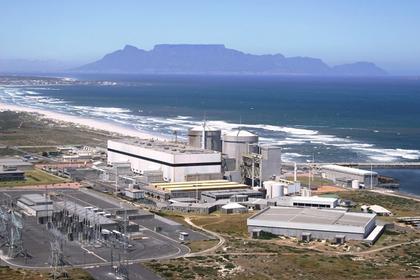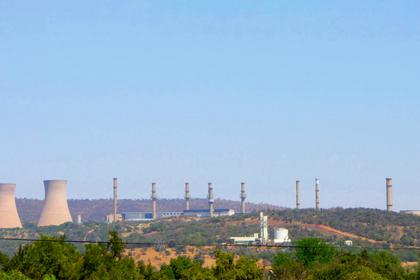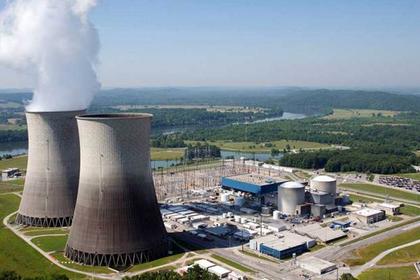
SOUTH AFRICA'S INFRASTRUCTURE PLAN 2050

SOUTH AFRICAN GOVERNMENT - 11 March 2022 - NATIONAL INFRASTRCTURE PLAN 2050 (NIP 2050) PHASE I
EXECUTIVE SUMMARY
Infrastructure development is critical to attaining South Africa’s long-term economic and social goals. In the context of a developing country seeking significant structural change, the public sector must lead this effort. Infrastructure delivery will be one of the most significant contributors to South Africa’s transition from a historically closed minerals economy to one that is globally and regionally integrated, low carbon, inclusive and promoting of dynamism in the industries of the future.
Public infrastructure investment is central to achieving greater productivity and competitiveness, reducing spatial inequality and supporting the emergence of new jobcreating sectors. It is therefore one of the non-negotiable foundations of transformation and inclusive growth. The construction of infrastructure generates employment and broad-based black economic empowerment opportunities, further contributing to the goals of the National Development Plan (NDP).
The NDP targeted a 30% investment-to-GDP ratio, one-third of which would be delivered by the state. This is primarily delivered through provincial and local government and state-owned enterprises (SOEs). A small proportion of spending is directed through national government.
The cost of delivering infrastructure to meet NDP development objectives is estimated to exceed R6 trillion between 2016 and 2040, with energy and transport accounting for over 72% of this spend.
The National Planning Commission (NPC) prepared an extensive review of public sector and SOE infrastructure delivery and performance, culminating in its December 2020 Review of Economic Progress. It found that the delivery of public sector infrastructure is below that required to support the NDP objectives. The NPC makes constructive and concrete recommendations for course correction.
The goal of the National Infrastructure Plan 2050 (NIP 2050) is to create a foundation for achieving the NDP’s vision of inclusive growth. Prepared by Infrastructure South Africa (ISA), the NIP 2050 offers a strategic vision and plan that link top NDP objectives to actionable steps and intermediate outcomes. Its purpose is to promote dynamism in infrastructure delivery, address institutional blockages and weaknesses that hinder success over the longer term, as well as guide the way towards building stronger institutions that can deliver on NDP aspirations. The NIP2050 identifies the most critical actions needed for sustained improvement in public infrastructure delivery. The NIP 2050 will have impact in the short term, but with longer-term imperatives also in view.
This phase of the NIP 2050 focuses on four critical network sectors that provide a platform: energy, freight transport, water and digital infrastructure. There will be a second phase that focuses on distributed infrastructure and related municipal services, as well as approaches to strengthening coordination through DDMs.
The NIP 2050 is organised into six main sections. The first section offers insight into the four mission-critical infrastructure areas, namely energy, freight transport, water and digital communications. There are then five cross-cutting sections focused on the regional agenda for infrastructure, finance, strengthening institutions for delivery, rebuilding the civil construction and supplier sector and the approach to monitoring and reporting on progress.
Each section follows the same format: (1) stating the vision, (2) offering a frank assessment of the current status, (3) outlining essential conditions for success and (4) stating what will be done to achieve the vision. With an eye to long-term success, there is significant emphasis on near-term course correction. To this end, the NIP 2050 outlines the changes and augmentation to government’s Strategic Integrated Projects (SIPs) that are relevant to the four sectors, as well as three-year action plans.
The NIP 2050 gives guidance on themes common to the four sectors, with significant emphasis in building capacity in the following:
• Knowledge and innovation services, for capability in planning, monitoring, budgeting, finance, procurement, project preparation, project management and sector-specific innovation. This enables evidence-based decision-making, improves cost-effectiveness, mitigates risk and helps optimise and can contribute significantly to improving infrastructure quality, delivery and sustainability. Building these capabilities will be the NIP’s top priority.
• Public-private cooperation and stimulation of competition, where appropriate, in the delivery of public infrastructure.
• Spatial transformation to promote more inclusive development in line with the National Spatial Development Framework (NSDF).
• Blended project finance and innovative green finance.
• Executive management and technical capability within the state and its entities, so that they are stable and can lead and deliver with confidence.
• Economic regulation.
• Industrial development and localisation in the design and approach to implementation.
Examples are localisation of supplier industries to infrastructure projects, driving the establishment of Special Economic Zones around intermodal transport linkage nodes, and the stimulation of the civil construction and supplier industries.
• Efficient modes of delivery.
• A safe, secure and ethical environment for public infrastructure delivery.
• Delivery of an Africa regional infrastructure programme.
• South African civil construction and supplier industries, so that local industry gains from state infrastructure investment.
Energy infrastructure
Energy supply will enable economic growth and development. The energy mix will be bolder on sustainability and in achieving least cost. This will require reduced reliance on coal and growing reliance on renewable energy, especially solar and wind, which play a dominant role as part of a least-cost energy mix and where South Africa has a significant advantage.
By 2050, energy demand is projected to double. Installed generation capacity will therefore need to expand, from 53 GW in 2018 to between 133 GW and 174 GW by 2050, depending on energy demand at that time. By 2030, at least 25 GW will have to be added to installed capacity with the requisite supportive transmission and distribution network infrastructure.
To achieve this vision for energy infrastructure, the NIP 2050 says that:
• the approach to defining the energy mix will become technically strong and responsive. Expanded capacity in a context of accelerated technological change and a changing energy mix requires that the institutional planning and delivery mechanisms become more adaptive, responsive and dynamic, as well as guided by evidence. The Integrated Resource Plan (IRP) will be revised to extend to 2050, and medium-term targets will be updated in 2021/2 to reflect a focus on sustainability and least cost. The IEP will be finalised.
• the market structure will facilitate more responsive and sustainable supply. This will require stabilisation and separation of Eskom, the introduction of greater private participation and more decentralisation in energy generation.
• capacity in the state and its entities will be strengthened to effectively regulate, plan and oversee energy delivery.
• electricity will be delivered in a financially sustainable way.
• energy efficiency policies and measures will be given high priority.
• the transition away from fossil fuels will progress in a measurable, just and sustained manner. New installed capacity consists primarily of wind and solar, where South Africa has a comparative and competitive advantage. Stakeholders, whether business, workers or communities, involved in fossil fuels will be supported through this transition.
• industrial diversification will be promoted through energy infrastructure delivery.
• a centralised database will be maintained, with the requisite confidentiality protection, for the reporting of existing and expected generation capacity investments by market players to enable informed power system planning and investments for all stakeholders.
• Research infrastructure for using nuclear technology will be sustained through the replacement of SAFARI-1 research reactor with a Multi-Purpose Reactor (MPR) by 2030.
• Effective management of waste emanating from energy generation to support environmental sustainability.
The SIPs will be augmented and 3-year priority actions to 2023/4 are outlined. For example, the independent transmission entity will be established and the 100 MW embedded generation will be regulated in 2021/2. At least 10 municipalities that deliver to large populations will be given support and/or have their capacity developed to adequately maintain distribution systems. A plan to reduce reliance on coal, including elements of a just transition, will be finalised in 2021/2, with implementation starting in 2022/3. The specifics on energy procurement are as follows: regularised prescheduled bi-annual bid windows procuring about 5GW of renewable power annually from independent power producers (IPPs), municipalities enabled to procure power from IPPs, acceleration of transmission and distribution infrastructure investment, and up to 1 000 MW battery storage procured by 2023/4.
Freight transport infrastructure
Freight transport will facilitate domestic and cross-border movement of goods to enable industrialisation, diversification, trade and development. It will deliver in respect of its three roles of supporting economic and industrial progress as well as enabling rural development, while ensuring environmental objectives are met regarding the reduction of emissions, congestion, accidents and waste.
To achieve the vision for freight transport, the NIP 2050 says that:
• transport policy will be integrated and oriented around supply chain needs and the mix drives efficiency. Transport services will become aligned with best practice, ensuring globally competitive economic growth.
• the reform of the freight transport sector will be done in a way that is sustainable and progressive. Market structure should become competitive. Scale is built into the dominant freight corridors to lower cost and improve competitiveness.
• state institutions will become increasingly capable of driving transport sector reform and delivery.
• funding and finance will be increasingly sustainable and make optimal use of opportunities to attract private finance.
• Africa regional transport networks will support interregional trade and better connectivity to global supply chains. South Africa’s position will be enhanced as a global maritime hub for Africa and the southern hemisphere.
• transport hubs will stimulate industrial diversification and clustering.
The freight transport SIPs will be augmented and 3 year priority actions to 2023/4 are outlined.
For example, the balance of transport projects will be reassessed in anticipation of the shift of cargo off the road to rail; that TFR will complete its accounting and commercial separation and meaningfully accommodate third-party operators by 2022/3; that both the independent ports authority and a single transport economic regulator will be established by 2022/3; that there will be a plan to integrate rail, road, ports and intermodal hubs and freight villages by 2022/3;
that a plan for Africa regional freight logistics will be prioritised; that the Port Master Plan, the National Rail Policy and the Road Funding Policy will be finalised; and that the upgrading of the six ports of entry to become one stop border posts be complete by 2025.
Water infrastructure
There will be universal and reliable access to water of an acceptable quality and quantity in support of a strong inclusive economy and a healthy environment. The institutions involved in managing water resources and services will be effective in achieving this objective.
To achieve the vision for water infrastructure, the NIP 2050 says that:
• decision-making will be accountable and the institutions involved in managing water made effective.
• water resource planning will become proactive, robust, responsive and guided by evidence.
• there will be coherence in water sector policy and support for implementation at the municipal level.
• capacity to finance and deliver water projects will be strengthened, with the private sector being used effectively. The water sector will become financially sustainable.
• existing water infrastructure will be rehabilitated and maintained and water use efficiencies improved.
• ecological infrastructure will be rehabilitated and protected.
• regulatory oversight and licensing regimes will become more robust, addressing both water quantity and quality, as well as pricing and the technical performance and financial sustainability institutions.
• roles and responsibilities will be aligned and consultation should be meaningful.
The existing water SIPs will be reviewed for their viability and augmented as indicated in the NIP. In addition, 3-year priority actions to 2023/4 are outlined. For example, the National Water Resources Infrastructure Agency will be established by 2023/4; a single national water regulator will be established in 2022/3; the raw water pricing strategy will be finalised in 2021/2; that the National Water Programme (NWP) project management office to support municipalities in water management and project development will be established in 2021/2; a plan for ensuring the viability of municipal wastewater plants will be created; a policy for water use in agriculture will be finalised in 2022/3; reconciliation strategies for all water systems will be finalised by 2022/3; at least two irrigated agricultural projects aimed at food production will be driven to implementation by 2023/4; that the viability of the water SIPs will be reviewed and other specific SIP projects will be added such as dam-raising projects for the Tzaneen and Clanwilliam dams, Sundays River subsystem expansion to serve Gqeberha, and water supply augmentation for Mbombela.
Digital communications infrastructure
Communications are the lifeblood of a market economy, and digital communications are increasingly central to that. The increasingly foundational role of digital transformation means that the benefits of becoming a fully digitally enabled society and economy outweigh the costs.
The NDP envisages a seamless information infrastructure that is universally available and accessible, at a cost and quality at least equal to South Africa’s peers and competitors. While South Africa is far off the NDP’s goals at 2021, the 2030 goals must remain in place.
There is evidence of sufficient capacity to deliver on these objectives if they are implemented through private-public cooperation.
To achieve the vision for digital infrastructure, the NIP 2050 says that:
• high-speed broadband will be universally accessible.
• regulation will enable competitive and universally accessible broadband.
• public sector capacity will be strong and able to drive the required policy agenda.
• partnerships will be strong and there should be centres of digital excellence promoting a growing knowledge base of delivery and innovation.
• the information and communications technology (ICT) skills base will be broad, robust and ready for the future.
• government services and buildings will be digitally enabled.
• private sector participation in achieving universal broadband access will be prevalent.
The digital SIPs will be deepened and augmented and 3-year priority actions to 2023/4 are outlined. For example, digital migration and spectrum auctions will take place in 2021/2, in that sequence; that the policy for rapid deployment of electronic communications networks and facilities will be finalised in 2021/2; that arrangements will be made to enable private participation in public interest digital delivery projects from 2022/3; that 80% of public buildings will be digitally enabled by 2024/5; that high-speed broadband will be accessible in every community by 2024/5; that there will be consideration of free basic data for low-income users; that government services be digitised; that a data centre strategy will be finalised in 2021/2; and that a satellite communications strategy will be finalised in 2021/2 for implementation beginning by 2022/3.
The NIP 2050 gives direction in respect of participation in regional infrastructure, infrastructure finance, the strengthening of institutions for delivery, an approach to rebuilding an empowered civil construction and supplier industry, and finally the monitoring and evaluation of infrastructure delivery.
Building a regional agenda for infrastructure
South Africa will demonstrate and execute on a bold vision for its infrastructure cooperation in the Africa region.
Initially, the NIP 2050 focuses on enabling delivery on regional projects that are critical to South Africa’s domestic needs and are also beneficial to regional development. In the near term, critical energy and water projects will be implemented with greater vigour, as will the development of high-efficiency border posts. In the medium term, South Africa will be an active driver of regional transport corridors in rail, road and ports that will greatly enhance the ease of regional trade. South Africa will also drive regional digital connectivity. As its construction sector is invigorated and infrastructure finance deepened, South Africa will play a greater role as a gateway into Africa and as a participant in delivering regional infrastructure projects and finance.
To achieve the vision for South Africa’s participation in regional infrastructure, the NIP 2050 says that:
• projects will progress timeously, with enhanced capacity, political commitment and focus.
• regional capacity to drive projects will be strengthened.
• project monitoring will enable action.
• South Africa will gain from foreign infrastructure investment in Africa
• a Financial Centre of Excellence will be established.
• a top-priority regional infrastructure integration strategy and project pipeline will be developed and implemented.
Infrastructure finance
Capacity will be in place to sustainably fund and finance infrastructure build, operations and maintenance. It is estimated that achieving the United Nation’s Sustainable Development Goals (SDGs) related to infrastructure and NDP infrastructure goals will cost R6,224 trillion between 2016 and 2040, with transport and energy likely accounting for over 72% of the investment required. As of 2021, the finance gap that needs to be closed is estimated at R2,15 trillion.
South Africa will have a thriving private sector infrastructure investment sector that will be supported by an efficient and reliable public sector procurement framework. This framework will deliver world-class procurement through both on-budget general government procurement and world-class capability in creating partnerships and alliances with the private sector in infrastructure finance, build and operations. Infrastructure projects will be considered from a full-life-cycle perspective: planning from procurement to decommissioning, budgeting, and setting out maintenance schedules that minimise costs over the life of the infrastructure. The public sector will partner with the private sector and development finance agencies to fill a finance gap of approximately one-third of the amount that needs to be invested until 2050.
Projects will be chosen for these partnerships where they clearly enhance the value of the infrastructure to the public. Such partnerships will be structured to maximise this value, considering all public policy objectives, with projects designed with risks allocated to partners that are best positioned to manage them. The NIP envisages government-wide capacity to design and launch partnerships with the private sector, eliciting an enthusiastic appetite for investment by the private sector and global development funders.
To achieve the vision for infrastructure finance, the NIP 2050 says that:
• a full-life-cycle planning approach will be adopted.
• value for money will be optimised.
• projects will be designed to meet the risk and return needs of investors.
• projects will be designed to minimise risk.
• partnerships with the private sector will be embraced where they deliver better value for money.
• development of the capital market will be supported by a steady and reliable pipeline of new projects.
• monitoring and reporting will be done in a way that builds investor confidence.
The institutional framework in support of infrastructure delivery
Strengthening institutions responsible for infrastructure planning and delivery will be the top priority of the NIP 2050. There must be a step change in the institutional capability that drives material progress in South Africa’s infrastructure ambition. Planning, procurement and execution systems and capabilities will be operating at the highest global standard, commensurate with the country’s significant infrastructure transformation agenda. Robust and ever-developing partnerships and alliances between the private and public sectors will be a significant feature in planning and implementation, whether they involve think tanks, financial institutions, business or communities. There will be confidence to drive an increasingly dynamic, high-performance delivery machinery.
The vision recognises that efficient and timeous delivery of public infrastructure requires an environment that is safe, secure and ethical.
To achieve the vision for institutional capacity, the NIP 2050 says that:
• there will be significant capacity development within infrastructure procurement and delivery management.
• the regulatory and institutional framework will enable network infrastructure procurement and delivery.
• a strategic approach will be taken to infrastructure procurement.
• systems of accountability will become aligned with effective infrastructure delivery.
• the asset management function will become robust.
• knowledge and innovation capabilities and services for planning, monitoring, budgeting, finance, procurement, project preparation, project management, risk mitigation (including opportunities for corruption) and sector-specific innovation will be strengthened.
• There will be significant attention to reducing crime and corruption and mitigating its impacts on public infrastructure delivery, especially in relation to: corruption in infrastructure procurement; extortion, political violence and unrest that halts infrastructure project progress; and vandalism and theft of infrastructure assets.
The civil construction and supplier sector
The South African civil construction and supplier sector will be a vibrant and respected, worldclass African full-service built-environment delivery provider that supports Southern African development and beyond. It will be cost-effective and offer safe and reliable service with an experienced and skilled workforce as well as world-class products relevant to the development context. It will be an industry that is inclusive in terms of representative ownership and business practices. The industry will have a wide range of continuously improving products and services delivered by companies that range from small domestic-oriented ones to large companies that can deliver regionally and globally.
To achieve the vision for the construction sector, the NIP 2050 says that:
• an explicit effort will be made to enable South Africa’s construction and supplier industries to deliver on the national development objectives.
• the state will oversee the procurement and delivery of infrastructure with a high-level of capability.
• the national infrastructure champion will be consolidated with supporting mechanisms and systems established.
• there will be a continuous pipeline of bankable projects that enables the construction sector to plan, invest and develop its people.
• regulations and the issuing of permits will be streamlined.
• there will be active and explicit support to strengthening emerging construction and supplier businesses and empowerment of historically disadvantaged entrepreneurs, while also eliminating mis-use of preferential procurement policies.
• There will be a drive to reduced carbon emissions in materials use and supplier industries.
Monitoring and reporting of major network infrastructure projects
Working with project owners, Infrastructure South Africa (ISA) will monitor the implementation of the NIP 2050. Monitoring and reporting to ISA and the PICC will focus on progress in implementing critical institutional reforms, the required capacity development and high-level information on the most important infrastructure projects. This will be done in a way that is transparent and up to date. ISA will report to the Presidential Infrastructure Coordinating Commission (PICC) Council from time-to-time on progress made in achieving the country’s infrastructure delivery vision and strategic objectives. The PICC Council is chaired by the President of South Africa and is comprised of elected representatives from all three spheres of government.
-----
Earlier:















